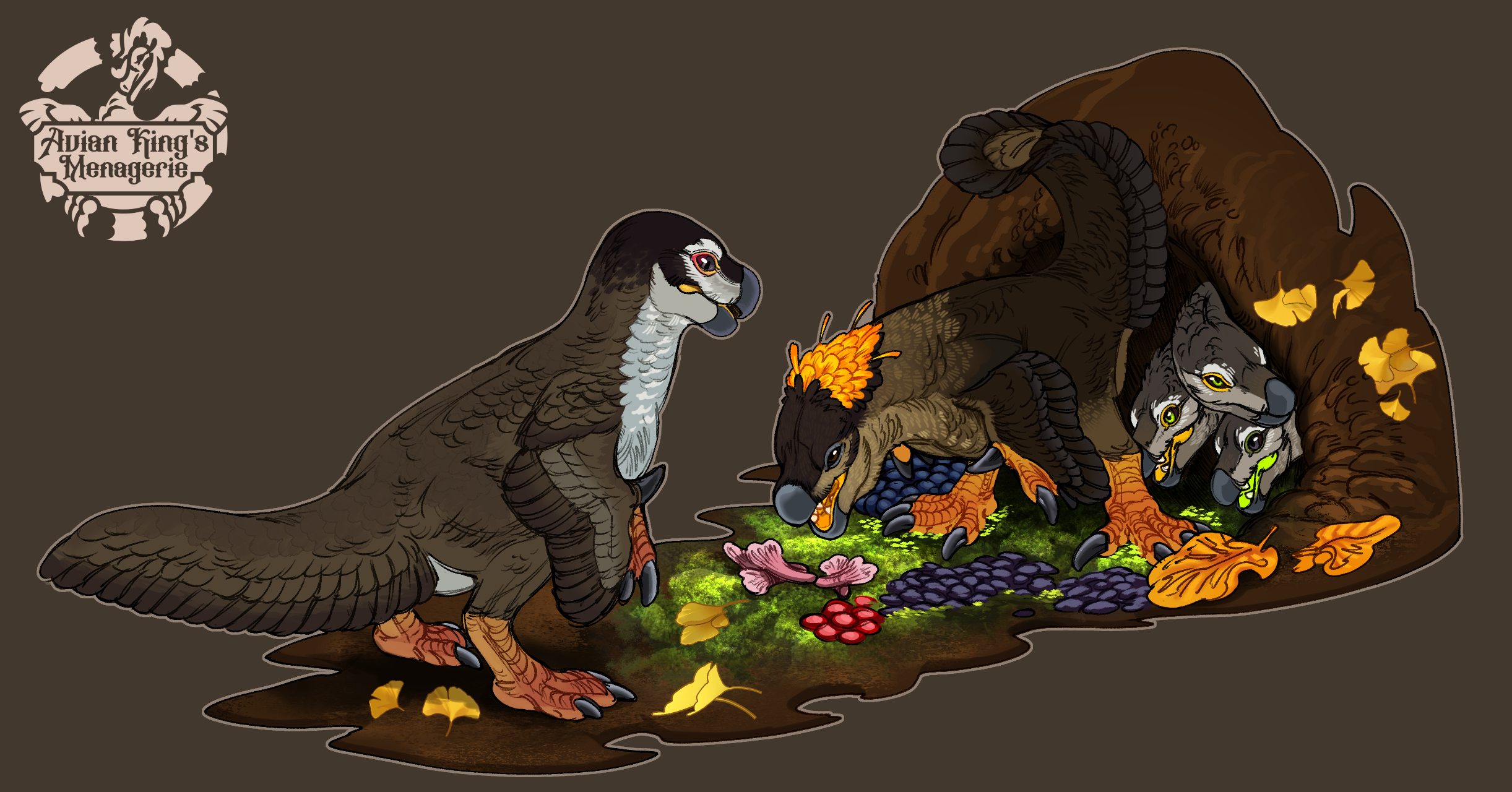The Courtship of the Carinian Burrowers
Execution
Burrowers are highly unusual compared to other members of the Plumebeast order. Burrowers are diminutive in scale and lack reversable toes (all 4 toes are forward facing- limited opposability.), 4th digit has been lost in order to streamline the forepaw for digging- resulting in a robust tridactyl paw with some reduction in flexile capabilities. The beak takes up much less prominence and the dentition of burrowers is reduced, resembling a Terran rabbit over a derived archosaur, making sense when considering the diet of Burrowers. In addition to morphological divergence, the Burrowers have also become uncharacteristic socially.
Social structureBurrowers have specialized hard into cooperative and altruistic habitability. They have taken advantage of older fossorial species in order to further their own evolution as well as adopting breeding practices that make collaboration required. Each successful colony or warren is operated by a presiding Fertilizer male, and his harem of 2-5 breeding hens (these hens being larger than the male). Thereafter there is an assortment of smaller males known as "Nestmakers". These males collect food, cultivate fungi and roots in specialized burrowers, manage the majority of the fossorial stock beasts, etc. Meanwhile the fertilizer male not only lives up to his namesake but excavates the main living chambers and protects the burrow from subordinate juvenile males. The Nestmakers get breeding opportunities with hens when the Fertilizer is not present (they may also engage in sex with the F-male in off seasons), and protection from the outside world. The output of Nestmaker-fertilizer males is dependant upon hormones in the hens at time of lay, and incubation temperatures. Outside of these individuals there are younger sexually immature individuals that have yet to set into a function outside of sex, the progeny of prior breeding periods. This system creates a psuedo-eusocial hierarchy amongst members of the clan.
When the event tends to startEvery few years when the juveniles come of age, they are expected to leave the warren to prevent inbreeding and food competition. The innate urge and parental push normally take place in spring. During this time new shoots are abundant, ground cover is denser, and soil is softer than it most of the year (good for starting a new burrow). Ounce ousted; usually at night, the new adults begin to dig burrows of their own meters or miles away from their birthplace. female siblings may pursue their brothers to take advantage of the shelter and protection they offer before heading out to either dig their own burrow or find a male to shack up with.
First phaseWhen the Fertilizer-males establish themselves in a suitable location they begin making calls that specifically attract the smaller Nestmaker males to their dens. The masculine team can then work on preparing the burrow for females. This includes creating nest chambers, larders, gardens, and decorating the entry way to catch the eyes of wandering females. Colourful leaves, berries, dead insects, fungi, feathers, bones, etc. are arranged in neat and colour coordinated piles in order to create a visually appealing display. As a byproduct of this process all members of the masculine unit become familiar with each other and learn how to sing to each other. This prepares the group for the next phase of the courtship process.
Second phaseOnce the burrow is ready to the best of the Male's ability the F-Male begins to call out to the forest. There is individual variation in the calls, but the females can tell from where they originate. The F-male takes lead while the N-males offer auditory support. Creating a bubbling melody to the ears of hens in the area. Interested hens will approach the virgin warren and make themselves known. The F-male will then exit the burrow if he hasn't already and begin a display. The display is usually initiated with pinning pupils and a lowered head. The nape feathers are spread apart revealing a patch of contrasting feathers varying from silver to red-orange. This creates a fanciful display for hens. His tail is then cast over his back dramatically and flicked periodically.
3rd phaseThe male will hop back and forth and snap his beak together rapidly, while fluttering his wings. He must do so carefully as to not disturb the coordinated piles of decor he and his trio have curated. The subordinate N-males act as backup singers and dancers, waving their heads out of the burrow entrance whilst chattering. It is not uncommon for the N-males to flash their nape feathers in sync with the F-male as a supporting act.
4th phaseIf the display is a success the female will receptively quiver her wings and tail and enter the burrow. There she will be guided to one of the nesting chambers and Be mounted by the presided F-male. Once he has finished and heads out to find food or prepare to court again the smaller N-males will take turns adding their seed to the genepool. This process will repeat itself up until all the hens attracted set in to lay olive-ochre eggs. All members will share incubation duty, the F-male serving the shortest time.
-ConclusionBurrower courtship is shared task between (usually) unrelated individuals. The cooperation of the members ensures not only a successful breeding season, but also a successful colony.



